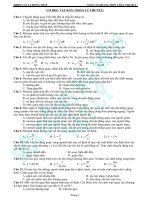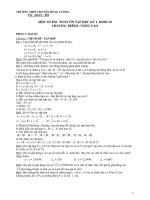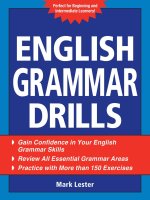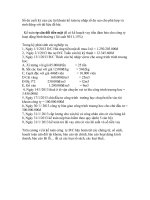lí thuyết và bài tập có đáp án phần mệnh đề quan hệ
Bạn đang xem bản rút gọn của tài liệu. Xem và tải ngay bản đầy đủ của tài liệu tại đây (135.47 KB, 9 trang )
MỆNH ĐỀ QUAN HỆ (RELATIVE CLAUSES)
1. Định nghĩa mệnh đề quan hệ (relative clause)
- Mệnh đề quan hệ là mệnh đề phụ được nối với mệnh đề chính bởi các đại từ quan
hệ (who, whom, whose, which, that) hay các trạng từ quan hệ như (where, when, why).
Mệnh đề quan hệ đứng ngay đằng sau danh từ, bổ sung ý nghĩa cho danh từ. Chức năng
của nó giống như một tính từ do vậy nó còn được gọi là mệnh đề tính ngữ.
Ví dụ: The man who told me this refused to give me his name.
- “who told me this “là mệnh đề quan hệ.
a. Mệnh đề quan hệ xác định (restrictive relative clause)
- Mệnh đề quan hệ xác định dùng để bổ nghĩa cho danh từ đứng trước, là bộ phận
quan trọng của câu, nếu bỏ đi mệnh đề thì danh từ không có nghĩa rõ ràng.
Ví dụ: 1. The girl who is wearing the blue dress is my sister.
“who is wearing the blue dress “ là mệnh đề quan hệ xác định.
2. The book which I borrowed from you is very interesting.
“who is wearing the blue dress “ là mệnh dề quan hệ xác định.
b. Mệnh đề quan hệ không xác định (non- restrictive relative clause)
- Mệnh đề quan hệ không xác định dùng để bổ nghĩa cho danh từ đứng trước,là phần
giải thích thêm và chỉ là thông tin phụ nếu bỏ đi mệnh đề chính vẫn còn nghĩa rõ ràng.
-Mệnh đề quan hệ không xác định thường được ngăn với mệnh đề chính bởi các dấu
phẩy. Danh từ đứng trước thường là danh từ riêng, danh từ thường có các tính từ chỉ trỏ:
this, that, these, those, hay tính từ sở hữu như my, his her…đứng trước, danh từ có bổ
nghĩa là cụm giới từ hoặc danh từ có duy nhất.
- Không được dùng that trong mệnh đề không xác định.
- Không được bỏ đại từ quan hệ trong mệnh đề quan hệ xác định.
Ví dụ : 1. My father, who works in this hospital, is a famous doctor.
“who works in this hospital” là mệnh đề quan hệ không xác định.
2. This girl, whom you met yesterday, is my daughter.
“whom you met yesterday” là mệnh đề quan hệ không xác định.
2. Các đại từ quan hệ
a. Who: Là đại từ quan hệ chỉ người làm chủ ngữ, đứng sau tiền ngữ chỉ người để
làm chủ ngữ cho động từ đứng sau nó.
- Theo sau who là một động từ.
Ví dụ: The man who robbed you has been arrested.
That is the boy who helped me to find your house.
b. Whom: Là đại từ quan hệ chỉ người làm tân ngữ, đứng sau tiền ngữ chỉ người để
làm tân ngữ cho động từ đứng sau nó.
- Theo sau whom là một chủ ngữ.
Ví dụ: The woman whom you saw yesterday is my aunt.
The boy whom we are looking for is Tom.
c. Which: Là đại từ quan hệ chỉ vật, làm chủ ngữ hoặc tân ngữ cho động từ sau nó.
-Theo sau which có thể là một động từ hoặc một chủ ngữ.
Ví dụ: This is the film which I like best.
. The book which I bought yesterday wasvery interesting.
d. That: Là đại từ quan hệ chỉ cả người lẫn vật, có thể được dùng thay cho Who,
Whom, Which trong mệnh đề quan hệ thuộc loại Restrictive relative Clause (Mệnh đề
quan hệ xác định)
Ví dụ : The book that I bought yesterday was very interesting.
My father is the person that I admire most.
Lưu ý : That còn được dùng trong các trường hợp:
+ Khi tiền ngữ là người và vật.
Ví dụ: I can see the girl and her dog that are running in the park.
+ Thường dùng làm tân ngữ cho động từ trong mệnh đề quan hệ xác định đứng sau
tiền ngữ có so sánh hơn nhất, first và last.
Ví dụ: This is the most interesting film that I’ve ever seen.
That is the last letter that he wrote.
+ Được dùng thay cho which trong mệnh đề quan hệ xác đinh khi được dùng sau
các từ: all, only (duy nhất) và very (chính là), much, none, no.
Ví dụ : All that he can say is this.
I bought the only book that they had.
You’re the very man that I would like to see.
+ Sau các đại từ bất định
Ví dụ: He never says anything that is worth listening to.
I’ll tell you something that is very interesting.
+ Thường dùng sau cấu trúc câu chẻ: It is…/ It was
Ví dụ It's the manager that we want to see.
It was the present that I gave him
+ Có thể dùng thay thế sau all, everyone, everybody, one, nobody and those:
Everyone who/that knew him liked him.
Nobody who/that watched the match will ever forget it.
e. Whose: Là đại từ quan hệ chỉ sở hữu của người hay vật.
- Theo sau Whose luôn là 1 danh từ.
Ví dụ : The boy is Tom. You borrowed his bicycle yesterday.
=> The boy whose bicycle you borrowed yesterday is Tom.
John found a cat. Its leg was broken.
John found a cat whose leg was broken.
3. Giới từ đi với đại từ quan hệ
- Khi Whom và Which là tân ngữ của giới từ thì trong tiếng Anh trang trọng giới từ
được đặt trước đại từ quan hệ. Nhưng thường thì giới từ được chuyển về cuối mệnh đề và
trong trường hợp này mệnh đề quan hệ xác định có thể lược bỏ đại từ quan hệ hoặc dùng
that thay thế cho whom hoặc which.
Ví dụ: The man is my brother. You are talking about him.
—> The man about whom you are talkingis my brother.
—> The man (whom/ that) you are talking about is my brother.
Ví dụ : The picture is very expensive. You are looking at it.
—> The picture at which you are looking is very expensive.
—> The picture ( which/ that) you are looking at is very expensive.
4. Rút gọn mệnh đề quan hệ
- Mệnh đề quan hệ có thể rút gọn theo 4 cách:
a. Sử dụng hiện tại phân từ (Using present participial phrases )
- Khi mệnh đề quan hệ xác định ở thể chủ động, ta có thể dùng cụm hiện tại phân từ
(V-ING phrase) thay cho mệnh đề đó (bỏ đại từ quan hệ và trợ động từ, đưa động từ
chính về nguyên mẫu rồi thêm –ing).
WHO
WHICH + V + … V-ING + …
THAT
Ví dụ: The man who is sitting next to you is my uncle.
The man sitting to you is my uncle.
Do you know the boy who broke the windows last night?
Do you know the boy breaking the windows last night?
b. Sử dụng cụm quá khứ phân từ (Using past participial phrase)
- Khi mệnh đề quan hệ xác định ở thể bị động, ta có thể dùng cụm quá khứ phân từ
(Ved/ V3 phrase) để thay thế cho mệnh đề đó. (Bỏ đại từ quan hệ, trợ động từ và bắt đầu
cụm từ bằng past participle).
WHO
WHICH + BE+ V-ed/V3 + … V-ed/ V3 + …
THAT
Ví dụ : 1. The books which were written by To Hoai are interesting.
The books written by To Hoai are interesting.
2. The students who were punished by the teacher are lazy.
The students punished by the teacher are lazy.
3. The house which is being built now belongs to Mr. Pike.
The house built now belongs to Mr. Pike.
c. Sử dụng cụm từ nguyên mẫu( infinitive phrase)
- Khi mệnh đề quan hệ theo sau danh từ có bổ ngữ là the first/second v.v. and sau
the last/ only và đôi khi sau so sánh nhất ta có thể thay thế bằng cụm từ nguyên mẫu.
Ví dụ : 1. He is the last man who left the ship = He is the last man to leave the ship.
2. The only one who understood that problem was M.r Pike
= The only one to understand that problem was M.r Pike
- Khi mệnh đề quan hệ là một mục đích ,nhiệm vụ hoặc sự cho phép.
Ví dụ: 1. He has a lot of book that he can/must read = He has a lot of book to
read.
2. He had something that he could/ had to do = He had something to do
3. They need a garden that they can play in = They need garden to play in
d. Sử dụng cụm danh từ (Using noun phrases)
Mệnh đề quan hệ không xách định có cấu trúc S+ be + noun có thể được rút gọn
bằng cách dùng cụm danh từ.
Ví dụ 1. George Washington, who was the first presidentof the United States, was a
general in the army.
George Washington, the first presidentof the United States, was a general in the
army.
2. We visited Barcelona, which is a city in northern Spain.
We visited Barcelona, a city in northern Spain.
5. Lược bỏ đại từ quan hệ: ( Omission of ralative pronouns)
Các đại từ quan hệ có chức năng tân ngữ trong mệnh đề quan hệ xác định đều có thể
lược bỏ.
Ví dụ : Do you know the boy (whom) we met yesterday?
That’s the house (which) I have bought.
Tuy nhiên các đại từ quan hệ có chức năng tân ngữ trong mệnh đề quan hệ không
xác định không thể lược bỏ.
Ví dụ: Mr Tom, whom I spoke on the phone to , is very interested in our plan.
Ta cũng không thể lượt bỏ đại từ quan hệ whom hay which khi nó đứng sau
giới từ. Muốn lược bỏ ta phải đưa giới từ về cuối mệnh đề.
6. Một số bài tập về mệnh đề quan hệ
*Chọn phương án trả lời đúng
1. The man to ………. She is married has been married twice before.
a. whom b. who c. which d. whose
2. We passed the shops ………… windows were decorated for Christmas.
a. the b. their c. which d. whose
3. Natasha, ………. flat was burgled, spent the night at a friend’s house.
a. who b. whose c. which d. that
4.Tom……….is a monitor of the class, is also the captain of the football.
a. who b. which c. whom d. whose.
5. The street…………leads to my school is very narrow.
a. who b. which c. whom d. whose.
6. Do you know the driver………………took them to town last night.?
a. which b. whom c. where d. who
7. Tom, ____ sits next to me, is from Canada.
a. that b. whom c. who d. whose
8. The little girl ____ I borrowed this pen has gone.
a. whose b. from who b. from that d. from whom
9. The speech ___ we listened last night was information.
a. to which b. which to c. to that d. that
10. The boy to ____ I lent my money is poor.
a. that b. who c. whom d. b and c
11. The knife ____ we cut bread is very sharp.
a. with that b. which c. with which d. that
12. The authority gathered those villagers ____ they explained the importance of forests.
a. who b. whom c. to whom d. to that
13. The boy ____ the piano is my son.
a. who is playing b. that is playing c. playing d. All are correct
14. We have apartment ____ the park.
a. overlooking b. overlooks c. to overlook d. overlooked
15. He was the last person ____ in this way.
a. to kill b. who killed c. being killed d. to be killed
* Nhận biết lỗi sai ( choose the word that needs corecting)
1. My sister has two children, who their names are Ali and Tal
A B C D
2. He is the second person be killed in that way.
A B C D
3. The waiter whom served us yesterday was polite and friendly.
A B C D
4. This class is only for people who’s first language is not Chinese.
A B C D
5. I like the diamond ring Mary is wearing it
A B C D
6. The man with who I spoke in the meeting used to work here.
A B C D
7. He is moving to Lang Son city, that is in the north-east of Viet Nam.
A B C D
8. She asked me if I knew whom had got the job.
A B C D
9. It was a kind of machine with that we were not familiar.
A B C D
10. They work in a hospital sponsoring by the government.
A B C D
* Combine these sentences using relative clauses, put commas where necesary
1. A woman answered the phone . She told me you was busy .
-> The woman who answer the phone told me you was busy
2. This bus is always crowded . I take it to school every morning .
-> This bus, which I take to school every morning, is always crowded
3. They are singing a song. I don’t know the song .
-> They are singing a song that I don’t know
4. John spoke to me . He was very helpful .
John, who spoke to me, was very helpful
5. A midwife is a woman. She assists other women in childbirth .
-> A midwife is a woman who assists other women in childbirth
6. They are the children . Their team won the match .
-> They are the children whose team won the match
7. The house is for sale . It has the green shutters .
-> The house that has the green shutters is for sale
8. My farther bought a motor bike . The motorbike costs 2 thousand dollars
-> My father bought a motobike that costs 2 thousand dollars
9. They thanked me for the postcards . I sent them from Australia.
-> They thanked me for the postcards that I sent from Australia
10. Mr Jone teaches me English . I am telling you about him.
-> Mr Jone, about whom I am telling you, teaches me English.
Rút gọn mệnh đề quan hệ thành cụm từ:
1. Neil Armstrong was the first man who walked on the moon
-> Neil Armstrong was the first man to walk on the moon
2. I come from a city that is located in the southern part of the country .
-> I come from a city located in the southern part of the country
3. The children who attend that school receive a good education .
-> The children attending that school receive good education
4. The scientists who are researching the causes of cancer are making progress .
-> The scientists researching the causes of cancer are making progress
5. They live in a house that was built in 1980 .
->They live in a house built in 1980
6. We have an apartment which overlooks the park .
-> We have an apartment overlooking the park
7. Yuri Gagarin became the first man who flied into space .
->YuriGagarin became the first man to fly into space.
8. We stood on the bridge which connects the two halves of the building .
-> We stood on the bridge connecting the two halves of the building
9. The vegetables which are sold in this supermarket are grown without chemicals.
-> The vegetables which sold in this supermarket are grown without chemicals.
10 She has a novel that she can read on her holiday.
-> She has a novel to read on her holiday









